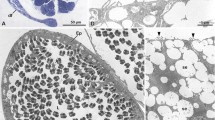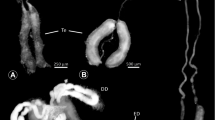Summary
The beetle family Altioidae contains some very archaic surviving species, and at the same time, very modern ones. In one lineage from archaic to modern (Fornterita — Alticini — Oedionychini), the number of spermatozoa has been stepwise (according to a geometric series, 2n) reduced from 256 to 16 per bundle. Comparison with the relatively few data in literature show that this trend is common in insects: more archaic orders have more sperm cells per bundle than the more modern ones, and within an order, the most modern or most specialized groups tend to have least. The reduced number of spermatozoa per bundle may be a sign of reduced sperm production in general, and this probably has adaptive value in limiting genetic variability.
A small number of spermatozoa per bundle is sometimes accompanied by an extra large size of spermatocytes. Except for the alticid subtribe Oedionychina, it is hard to see what adaptive value this could have. In the Oedionychines, the large size of the spermatocytes is a prerequisition for the evolution of gigantism of the asynaptic sex chromosomes.
Similar content being viewed by others
References
Bechyné, Jan.: Universidad Central de Venezuela, Maracay, Venezuela (Personal communications 1967, 1968, 1969).
Blackman, M. W.: Spermatogenesis of the myriapods. Notes on the spermatocytes and spermatids of Scolopendra L. Kansas Univ. Quart. 10, 61–78 (1901).
—: The spermatogenesis of myriapods. III. The spermatogenesis in Scolopendra heros. Bull. Mus. Comp. Zool. Harvard Univ. 48, 1–137 (1905a).
—: The spermatogenesis of myriapods. IV. On the karyosphere and nucleolus in the spermatocytes of Scolopendra subspinipes. Proc. Amer. Acad. Arts Sci. 41, 329–344 (1905b).
—: The spermatogenesis of myriapods. V. On the spermatocytes of Lithobius. Proc. Amer. Arts. Sci. 42, 487–518 (1907).
Cantacuzène, A.-M.: Recherches morphologiques et physiologiques sur les glandes annexes mâles des orthoptères. III. Modes d'association des spermatozoiides d'orthoptères. Z. Zellforsch. 90, 113–126 (1968).
Cooper, K. W.: Normal spermatogenesis in Drosophila. In: Biology of Drosophila (Demerec edit.), p. 1–61. New York: Wiley 1950.
Cretschmar, M.: Das Verhalten der Chromosome bei der Spermatogenese von Orgyia thyellina Btl. und antigua L. sowie eines ihrer Bastarde. Z. Zellforsch. 7, 290–399 (1928).
Depdolla, P.: Die Keimzellenbildung und die Befruchtung bei den Insekten. In: Handbuch der Entomologie (Schröder edit.) Bd. 1, S. 825–1116 (1928).
Dietz, R.: Multiple Geschlechtschromosomen bei den Cypriden Ostracoden, ihre Evolution und ihr Teilungsverhalten. Chromosoma (Berl.) 9, 359–440 (1958).
- Max-Planck-Institut für Zellenbiologie, Abt. Bauer, Tübingen, Germany (personal communication, 1968).
Dikshith, T. S. S.: Spermatogenesis in Laccifer lacca (Kerr) (Lacciferidae-Coccoidea). Cytologia (Tokyo) 31, 302–308 (1966).
Doutt, R. L.: A comparative study of spermatozoa in relation to classification of mealy bugs. Hawaii Entom. Soc. Proc. 14, 391–397 (1951).
—: The spermatozoon as a diagnostic tool in mealy bug taxonomy. J. econ. Entom. 42, 835 (1966).
Halkka, O.: Studies on mitotic and meiotic cell division in certain Hemiptera under normal and experimental conditions. Ann. Acad. Sci. fenn. A IV 32, 1–80 (1956).
- Cytophotometric studies on the spermatogonia of Nepa cinerea (Hemiptera). Proc. XIth Intern. Congr. Genetics, vol. I (1963).
Hannah-Alava, A.: The premeiotic stages of spermatogenesis. Adv. Genet. 13, 157–226 (1965).
Hughes-Schrader, S.: The chromosome cycle of Phenacoccus (Coccidae). Biol. Bull. 69, 462–468 (1935).
—: A new type of spermiogenesis in iceryine coccids, with linear alignment of chromosomes in the sperm. J. Morph. 78, 43–84 (1946).
—: Cytology of coccids (Coccoidea — Homoptera). Advanc. Genet. 2, 127–203 (1948).
Janssens, F. A.: La Chiasmatypie dans les insectes. Spermatogénèse dans 1° Stethophyma grossum (L.), 2° Chorthippus parallelus (Zetterstedt). Cellule 34, 133–539 (1924).
Kawaguchi, E.: Cytologische Untersuchungen am Seidenspinner und seinen Verwandten. I. Gametogenese von Bombyx mori L. und Bombyx mandarina M. und ihrer Bastarde Z. Zellforsch. 7, 519–552 (1928).
Knaben, N.: Spermatogenese bei Tischeria angusticolella Dup. Z. wiss. Biol. 13, 290–323 (1931).
Lutman, B. F.: The spermatogenesis of the caddisfly (Platyphylax designatus Walker). Biol. Bull. 19, 55–72 (1910).
Makino, S., and H. Niiyama: The chromosomes of Scolopendra damnosa L. Koch (Chilopoda). Jap J. Genet. 18, 34–40 (1942).
Matthews, E.: Department of Biology, University of Puerto Rico, Río Piedras, Puerto Rico (personal communication, 1969).
McClung, G. E., and J. J. Asana: The auxocytes of Schizodactylus monstrosus. Cytologia 6, 51–61 (1933).
Medes, G.: The spermatogenesis of Scuticera forceps. Biol. Bull. 9, 156–186 (1905).
Meyer, G. F.: Die Funktionsstrukturen des Y-Chromosoms in den Spermatocytenkernen von Drosophila hydei, D. neohydei, D. repleta und einigen anderen Drosophila-Arten. Chromosoma (Berl.) 14, 207–255 (1963).
—: Spermiogenese in normalen und Y-defizienten Männchen von Drosophila, melanogaster und D. hydei. Z. Zellforsch. 84, 141–175 (1967).
Mintz, B., and E. Russel: Gene-induced embryological modifications of primordial germ cells in the mouse. J. exp. Zool. 134, 207–230 (1957).
Nur, U.: Sperms, sperm bundles and fertilization in a mealy bug, Pseudococcus obscurus Essig. (Homoptera: Coccoidea). J. Morph. 111, 173–199 (1962).
Oksala, T.: Zytologische Studien an Odonaten. II. Die Entstehung der meiotischen Präkozität. Ann. Acad. Sci. fenn. A IV 5, 1–33 (1944).
Omura, T.: The spermatogenesis of an Indian dragonfly, Ictinus rapax (Rambur), with special reference to the behavior of the spermatozoa in the cyst. Biol. J. Okayama Univ. 1, 103–146 (1952).
—: A comparative study of the spermatogenesis in the Japanese dragonflies. I. Family Libellulidae. J. Okayama Univ. 2, 95–135 (1955).
—: A comparative study of the spermatogenesis in the Japanese dragonflies. II. Family Aeschnidae, Gomphidae, and Calopterygidae. J. Okayama Univ. 3, 1–86 (1957).
Reuter, E.: Beiträge zu einer einheitlichen Auffassung gewisser Chromosomenfragen. Acta zool. fenn. 9, 1–484 (1930).
Sado, T.: Spermatogenesis of the silkworm and its bearing on the radiation-induced sterility. Japan. J. Genet. 36, 136–151 (1961).
Schrader, F.: Experimental and cytological investigations of the life cycle of Gossyparia spuria (Coccidae) and their bearing on the problem of haploidy in males. Z. wiss. Zool. 134, 149–179 (1929).
—, and C. Leuchtenberg: A cytochemical analysis of the functional interrelations of various cell structures in Arvelius albopunctatus (De Geer). Exp. Cell Res. 1, 421–452 (1950).
Suomalainen, H.: Localization of chiasmata in the light of observations on the spermatogenesis of certain Neuroptera. Ann. zool. Soc. “Vanamo” 15, 1–104 (1952).
Virkki, N.: Zur Zytologie einiger Scarabaeiden (Coleoptera). Ann. zool. Soc. “Vanamo” 14, 1–104 (1951).
—: Weitere Spermatogenesestudien an Skarabäiden (Coleoptera). Ann. Acad. Sci. fenn. A IV 25, 1–58 (1954).
—: Zur Kenntnis der postmeiotischen Ereignisse der Samenentwicklung bei den Skarabäiden (Coleoptera). Z. Zellforsch. 44, 644–665 (1956).
—: Gametogenesis in the sugarcane borer moth, Diatraea saccharalis (F.) (Crambidae). J. Agric. Univ. Puerto Rico 47, 102–137 (1963).
—: Chromosome relationships in some North American Scarabaeoid beetles, with special reference to Pleocoma and Trox. Canad. J. Genet. Cytol. 9, 107–125 (1967a).
—: Initiation and course of male meiosis in Scarabaeoid beetles, with special reference to Pleocoma and Lichnanthe (Coleoptera: Scarabaeoidea). Pan-Pacific Entom. 43, 99–112 (1967b).
—: A Chiasmate sex quadrivalent in the male of an alticid beetle Cyrsylus volkameriae (F.). Canad. J. Genet. Cytol. 10, 898–907 (1968).
- Sex chromosomes and karyotypes of the Alticidae (Coleoptera). Hereditas (Lund) (1970, in the press).
White, M. J. D.: The cytology of the Ceciodomyidae (Diptera). The chromosome cycle and anomalous spermatogenesis of Miastor. J. Morph. 79, 323–370 (1946).
—: Cytological studies on gall midges (Cecidomyidae). Univ. Texas Publ. 5007, 1–80 (1950).
—: Pattern of spermatogenesis in grasshoppers. Austr. J. Zool. 3, 222–226 (1955).
Author information
Authors and Affiliations
Additional information
Partly supported by a grant (GB-4522) from the National Science Foundation (Washington).
I wish to express my gratitude to Prof. Dr. Jan Bechyné, Instituto de Zoología Agrícola, Universidad Central de Venezuela, Maracay, Venezuela, for identification of most alticids mentioned in this paper.
Rights and permissions
About this article
Cite this article
Virkki, N. Sperm bundles and phylogenesis. Z. Zellforsch. 101, 13–27 (1969). https://doi.org/10.1007/BF00335583
Received:
Issue Date:
DOI: https://doi.org/10.1007/BF00335583




